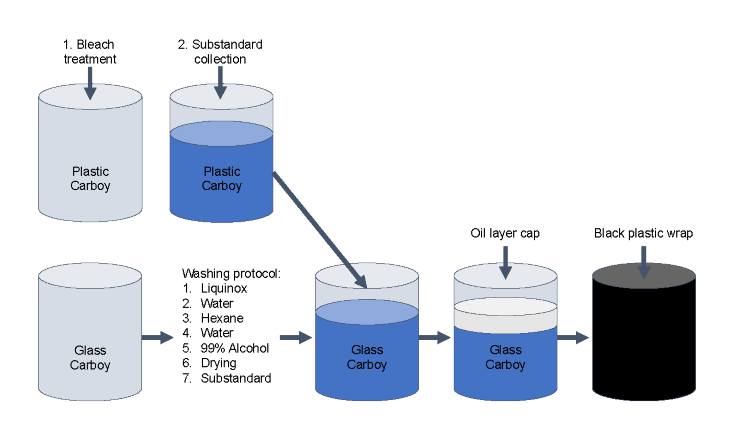|
Hawaii Ocean Time-series (HOT)
in the School of Ocean and Earth Science and Technology at the University of Hawai'i at Manoa |
|
| » Home » Analytical Results » Salinity | ||||||||
Sampling ProcedureSalinity samples are collected, stored and analyzed on an Autosal salinometer as described in Tupas et al. (1993). 1. Sampling and storage Salinity samples are taken from the Niskin rosette into glass bottles. Each bottle is rinsed three times with the sample and then filled up, and a stopper is inserted between the bottle and the cap to prevent evaporation. A duplicate set of samples is taken during a deep cast on each cruise, to assess reproducibility. Bottles are then stored in dark boxes, and analyzed in the lab upon return from sea. The bottles are left to equilibrate at a controlled room temperature for at least 24 hours before analysis. 2. Analysis The samples are analyzed using a Guideline Autosal salinometer. Each sample bottle is run twice or three times, depending on the standard deviation after the first two runs. Measurement precision is around 1mpsu (0.001). Room temperature is kept between 22-25oC. The bottle measurements are used to do a primary calibration of the CTD salinity data, and the CTD profiles are, in turn, used to infer and flag questionable and bad bottle salinity measurements. 3. Standardization IAPSO seawater is used for standardization prior to analysis of each cruise, and then re-analyzed once during- and once after each set of cruise samples to verify stability. Additionally, samples from a large batch of secondary standard (substandard) seawater are measured after every 24-48 samples to detect drift in the salinometer. The secondary standard seawater batches are made every few months from 60 liters of seawater taken from a depth of 1000 m from Station ALOHA. to making each substandard batch, all materials and supplies are cleaned thoroughly (Figure A). The plastic carboy used to collect the Substandard seawater on the cruise is bleached before collection. The glass carboys are washed with Liquinox, rinsed with water, hexane, rinsed with water again, and then rinsed with 99% alcohol before drying. The glass rods are rinsed with hexane and 99% alcohol. The carboy (and glass rod) are rinsed with the collected Substandard water before being filled, and then capped with a layer of white oil to prevent oxygenation and evaporation. The filled carboy is then wrapped in black bags to prevent light from reaching the stored Substandard water.  Figure A: Cleaning and collection protocol for substandard batches. ResultsFigure 10 and Figure 11 show the contoured time-series record for salinity in the upper 1000 dbar for all HOT cruises through 2022. Some of the bottles in Figure 11 are plotted at density values lower than the indicated sea surface density. This is due to surface density changing from cast to cast within each cruise and even between the downcast and the upcast during a single cast. Surface salinity varies from cruise to cruise, with no apparent seasonal cycle and some substantial interannual variability. The salinity maximum is generally found between 50 and 150 dbar and within 24-25 σθ. Salinity anomalies in the salinity maximum seem to be related to rainfall anomalies in the central North Pacific dominated by basin-scale oscillations such as ENSO (El Niño/Southern Oscillation) and the PDO (Pacific Decadal Oscillation) (Lukas, 2001). The salinity minimum is found between 400 and 600 dbar (26.35-26.85 σθ). There is no obvious seasonal variation in this feature, but there are distinct periods of higher than normal minimum salinity. These variations are related to the episodic appearance at Station ALOHA of energetic fine structure and sub-mesoscale water mass anomalies (Lukas and Chiswell, 1991; Kennan and Lukas, 1995). The anomalous high salinity centered at 400 dbar in early 2001 was apparently caused by the passing of an eddy during HOT-122 ( Lukas and Santiago-Mandujano, 2001). This caused anomalous values in all the hydrographic variables observed at the ALOHA station. A similar feature centered at 350 dbar was observed in mid-2012 during HOT-241, however its anomalous values were not as extreme as during HOT-122. Detailed records of features observed over the years can be found in the Yearly Data Reports. | ||||||||


